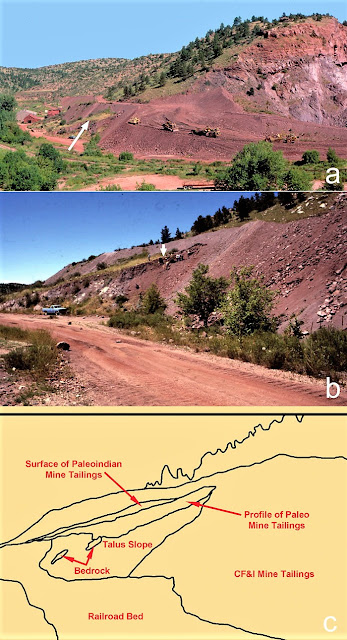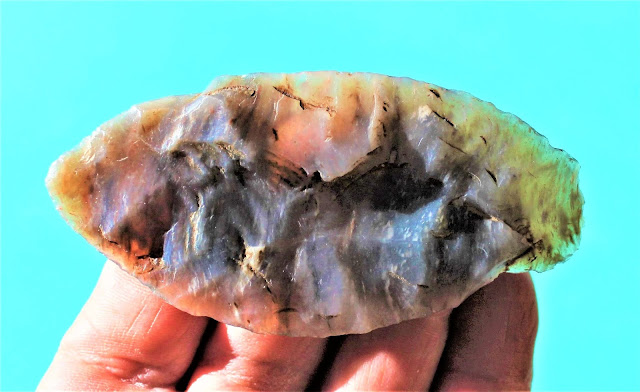 |
|
|
The SHADOWS on the TRAIL Pentalogy captures realistic Paleoindian life on the High Plains of North America over 12,600 years ago. Join those rugged people on countless adventures and see if you have what it takes to survive the ordeals and challenges facing Paleoindians.
Friday, October 26, 2018
Tuesday, October 9, 2018
Who Dun It? Clovis, Folsom, or Something Else? Part IV
 |
| Figure One - 3.5-inch long semi-translucent biface, a surface find from private land in south-central Wyoming. John Bradford Branney Collection. |
There is a fair chance that the beautiful biface in figure one is an ultrathin knife form from a Paleoindian prehistoric culture from 11,000 to 13,000 plus years ago. Why do I say fair chance and I am not more definitive? Because the late Jim Roth surface found this artifact on private land in Carbon County, Wyoming, and it was a surface find discovered out of archaeological context. Since surface artifact hunters must be 'part detective' when it comes to identifying some artifacts, I will provide some evidence for a prehistoric culture I think it came from. But first, I want to explore a passage from my historical fiction book on Paleoindians titled GHOSTS of the HEART.
For those of you who have not read my popular prehistoric adventure series about the Folsom People, the SHADOWS on the TRAIL Pentalogy, my main character Chayton and other hunters in his tribe carried ultrathin knife forms to filet meat from the prey animals they butchered. In this scene, Chayton and the hunters set up a trap and harvested a small herd of bison. I imagine hunting bison back 12,600 years ago when the book took place was hard work. Butchering bison was probably even harder work.
When it was all over, the tribe had killed twenty-two tatanka – bison. The meat from the herd would help the tribe through wani yetu – winter. One of the hunters ran to the camp to tell the people of the tribe. Before long, the entire tribe had returned to help butcher and carry the meat back to the camp. First, everyone in the tribe helped lay all of the carcasses on their bellies with legs sprawled. Then a team of two or three butchers worked on each carcass; while one person held and positioned the carcass, the other person chopped, sawed and cut. The team of butchers then cut the hide lengthwise down the back.
 |
| Figure Two - CLICK to ORDER |
They then pulled the hide to the ground on both sides of the carcass, creating a mat that would protect the butchered meat from the ground. The team of butchers extracted the tender cuts of meat under the skin of the back first, followed by the forelegs, shoulders, hump meat, rib cage, and body cavity. They would not waste anything. The team of butchers opened up each body cavity and removed the heart, liver, and gall bladder.
With hammer stones, choppers, and stone knives, the butchers then harvested the hindquarters, hind legs, neck, and skull. As the team of butchers systematically stripped the meat from the carcasses, others carried the meat back to the camp where they cut it into strips and hung it from sagebrush and tree branches to dry. The Folsom People would make pemmican from the meat that was too tough to eat. They then extracted two more delicacies from the skull, the tongue, and the brain.
Now that I gave you a taste for GHOSTS of the HEART, let's go back to the knife form in question. I believe that this knife form is definitely Paleoindian, either a Folsom ultrathin knife form or a Clovis ovate biface.
Why? Let me outline my logic.
1. The dimensions of this knife form are: 88 mm long, 42 mm wide, and 5 mm thick, giving it a width to thickness ratio of 8.4, well within the arbitrary width to thickness ratio for ultrathin knife forms of 7 or greater.
2. The raw material is wild: a beautiful semi-translucent, banded petrified wood.
 |
| Figure Four - Powars II red ocher archaeological site in east central Wyoming. |
3. In several flake terminations, there appear to be oxidized iron deposits or staining, much like you would find when red ochre was applied. Ochre is a natural mineral containing ferric oxide. It is typically associated with clay and varies in color from light yellow to brown to red. Red ochre has been found in many different archaeological contexts including Paleoindian occupation floors. Paleoindians sometimes painted their tools and projectile points with red ochre. Red ochre has also been associated with Paleoindian burials. Red ochre was widely used at Paleoindian levels at Powars II, Hanson, Hell Gap, Sheaman, and the Medicine Lodge Creek archaeological sites in Wyoming. Investigators discovered a grinding slab used for pulverizing red ochre nodules and rocks into powder at the Folsom level at the Agate Basin site in eastern Wyoming.
4. We know prehistoric people used different types of ochre for paint pigment, and we assume they used it for both functional and ritualistic reasons. Upper Paleolithic graves in Europe and at least one Clovis grave in the United States contained ochre. Ochre appeared to have an application in the Magdalenian in Europe as an ingredient in an adhesive that was used to haft knife forms and projectile points to handles and foreshafts. Perhaps, North American Paleoindians used red ochre as an adhesive for fastening projectile points and knives to spears and handles. We also know that red ochre preserves wood. That would explain the occurrence of red ochre in the hafting area of many Clovis projectile points. Some investigators also believe that Paleoindian flintknappers in North America might have used red ochre as an abrasive to polish and dull the lateral edges in the hafting areas of projectile points. Dulling the edges was a common practice in Paleoindian and Early Archaic times. We assume this dulling was done to prevent the edge of the stone artifact from cutting the sinew lashings. Red ochre is also commonly found with Clovis tool caches but we cannot be sure of the purpose.
5. It is not coincidently that the predominant colors used in rock art and cave art in the Old World and in some cases, New World, were black (from charcoal, soot, or manganese oxide), yellow ochre (limonite), red ochre (hematite or burned limonite) and white (kaolin clay, burnt shells, powdered gypsum, or powdered calcium carbonate).
 |
| Figure Five - Clovis and Paleoindian biface thinning sequence. From The Agate Basin Site by George C Frison and Dennis J. Stanford. |
6. I love Paleoindian flintknapping, especially the biface thinning through percussion technology. The flaking on the artifact in figures one, three, and six screams out as Paleoindian origin. Paleoindians attacked a piece of flint with carefree, but skilled abandon. The Paleoindian flintknapper's attitude must have been "why thin a biface with ten swings of a hammer when five swings accomplish the same result." Paleoindians thinned bifaces with wide, thin flakes that crossed the face of the biface, sometimes overshooting the other edge (see figure five). The end result was wide, thin, and long flakes that were exceptionally flat which thinned the biface without losing overall length or width. On the artifact in figures one, three, and six; several of these wide-thin-flat flakes terminate midway across the face of the biface, creating step or hinge terminations in the middle of the artifact. These diving flakes created a biconcave cross-section for this knife form. Some of these diving flakes were met by diving flakes from the other side, creating an even more concave profile in the middle of the artifact.
Few knife form or biface types are culturally diagnostic. It usually takes finding them in situ under controlled archaeological and geological conditions to determine age or cultural affiliation. This knife form was a surface find but I am hypothesizing that it either came from the Folsom or Clovis Paleoindian culture based on its production technology, knapping characteristics, and the presence of oxidized red ochre.
But, just because that is what I think does not make it necessarily so.
Disclaimer: I have NOT had this knife form 'officially' tested for the presence of red ochre, although several knowledgeable collectors and archaeologists have looked it over and concluded the same thing. My assumption that it is red ochre is from those opinions, my experience and research, and observation of the deposits under high magnification.
So, what is your opinion? Is it a Clovis Ovate Biface
or a Folsom Ultrathin Knife or maybe something else altogether?
The historical fiction novels written by John Bradford Branney are known for their impeccable research and biting realism. In his soon-to-be-released blockbuster Beyond the Campfire, Branney catapults his readers back into Prehistoric America where they reunite with some familiar faces from Branney’s best-selling prehistoric adventure series the Shadows on the Trail Pentalogy.
John Bradford Branney holds a geology degree from the University of Wyoming and MBA from the University of Colorado. John lives in the Colorado mountains with his wife, Theresa. Beyond the Campfire is the eleventh published book by Branney.
Subscribe to:
Comments (Atom)





